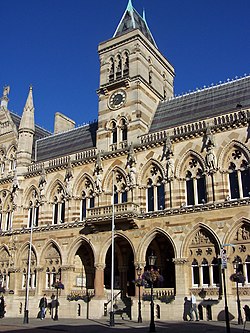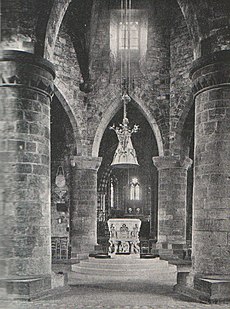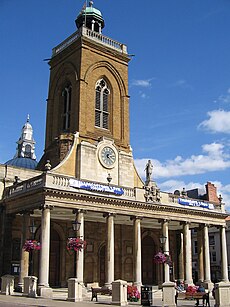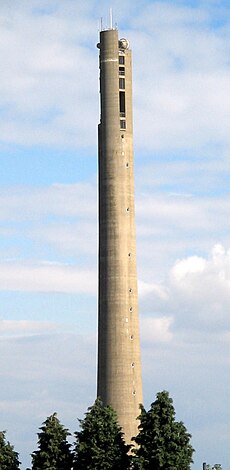Northampton: Difference between revisions
Created page with '{{Infobox town |name=Northampton |county=Northamptonshire |picture= Northampton Guildhall01.JPG |picture caption=Northampton Guildhall |os grid ref= SP76955625 |latitude= 52.1986…' |
No edit summary |
||
| Line 13: | Line 13: | ||
|constituency=Northampton North<br>Northampton South | |constituency=Northampton North<br>Northampton South | ||
}} | }} | ||
'''Northampton''' is a large [[market town]] in [[Northamptonshire]], of which it is the [[county town]]. The | '''Northampton''' is a large [[market town]] in [[Northamptonshire]], of which it is the [[county town]]. The town stands on the [[River Nene]] and is a mixture of old and new; the town is an ancient borough and the town centre has many historic buildings, but Northampton was declared a “new town” in 1968 and consequently all around it has sprung modern new-town suburbs. | ||
==Economy== | ==Economy== | ||
| Line 29: | Line 29: | ||
In 1189 King Richard I gave the town its first charter. In 1215 King John authorised the appointment of William Tilly as the town's first Mayor and ordered that: '' 'twelve of the better and more discreet residents of the town join him as a council to assist him' ''. In 1176 the Assize of Northampton laid down new powers for dealing with law breakers. | In 1189 King Richard I gave the town its first charter. In 1215 King John authorised the appointment of William Tilly as the town's first Mayor and ordered that: '' 'twelve of the better and more discreet residents of the town join him as a council to assist him' ''. In 1176 the Assize of Northampton laid down new powers for dealing with law breakers. | ||
Northampton had a large Jewish population in the 13th century, | Northampton had a large Jewish population in the 13th century, centred around Gold Street. In 1277, 300 Jews were killed, accused of clipping the coinage, and the survivors were driven out of the town. Archaeological sites include a mediæval Jewish cemetery and the Northampton Mediæval Synagogue.<ref>''Northampton synagogue discovered under kebab shop'': Jewish Chronicle - Marcus Dysch - April 15, 2010 [http://www.thejc.com/news/uk-news/30503/northampton-synagogue-discovered-under-kebab-shop TheJC.com]</ref> | ||
The University of Northampton was established in 1261 by scholars from University of Cambridge but it was dissolved by Henry III in 1265 apparently as it posed a threat to the University of Oxford. In the previous year King Henry's forces defeated those of Simon de Montfort at the Battle of Northampton. A second Battle of Northampton was 1460; a decisive battle of the Wars of the Roses in which King Henry VI was captured by the Yorkists. | The University of Northampton was established in 1261 by scholars from University of Cambridge but it was dissolved by Henry III in 1265 apparently as it posed a threat to the University of Oxford. In the previous year King Henry's forces defeated those of Simon de Montfort at the Battle of Northampton. A second Battle of Northampton was 1460; a decisive battle of the Wars of the Roses in which King Henry VI was captured by the Yorkists. | ||
Revision as of 15:51, 5 August 2014
| Northampton | |
| Northamptonshire | |
|---|---|
 Northampton Guildhall | |
| Location | |
| Grid reference: | SP76955625 |
| Location: | 52°11’55"N, -0°52’26"W |
| Data | |
| Population: | 189,474 (2001) |
| Local Government | |
| Council: | West Northamptonshire |
| Parliamentary constituency: |
Northampton North Northampton South |
Northampton is a large market town in Northamptonshire, of which it is the county town. The town stands on the River Nene and is a mixture of old and new; the town is an ancient borough and the town centre has many historic buildings, but Northampton was declared a “new town” in 1968 and consequently all around it has sprung modern new-town suburbs.
Economy
Northampton is famed as the major centre of shoemaking and other leather industries, though the industry is no longer so predominant in the town. Some specialist shoemaking companies such as Church's and Trickers are based in the town. A large number of old shoe factories remain, mostly now converted to offices or accommodation, some of which are surrounded by terraced houses built for factory workers. Northampton's main private-sector employers are now in distribution and finance rather than manufacturing, with several major household names based in and around Northampton.
History
Early history
Northampton as a town was an Anglo-Saxon foundation, the town known as Hamtun until the eleventh century. Though a small town, it gave its name to Hamtunscir, now Northamptonshire.
Mediæval
The town became significant in the 11th century, when the Normans built town walls and a large castle under the stewardship of the Norman earl, Simon de Senlis.[1] The original defence line of the walls is preserved in today's street pattern (Bridge St, The Drapery, Bearward St and Scarletwell Street). The town grew rapidly after the Normans arrived, and beyond the early defences. By the time of the Domesday Book, the town had a population of about 1,500 residents, living in 300 houses.
The town and its castle were important in the early 12th century and the King often held Court in the town. During thew dispute between Thomas Becket, Archbishop of Canterbury, and King Henry II, Becket escaped from Northampton Castle through the unguarded Northern gate to flee the country.
In 1189 King Richard I gave the town its first charter. In 1215 King John authorised the appointment of William Tilly as the town's first Mayor and ordered that: 'twelve of the better and more discreet residents of the town join him as a council to assist him' . In 1176 the Assize of Northampton laid down new powers for dealing with law breakers.
Northampton had a large Jewish population in the 13th century, centred around Gold Street. In 1277, 300 Jews were killed, accused of clipping the coinage, and the survivors were driven out of the town. Archaeological sites include a mediæval Jewish cemetery and the Northampton Mediæval Synagogue.[2]
The University of Northampton was established in 1261 by scholars from University of Cambridge but it was dissolved by Henry III in 1265 apparently as it posed a threat to the University of Oxford. In the previous year King Henry's forces defeated those of Simon de Montfort at the Battle of Northampton. A second Battle of Northampton was 1460; a decisive battle of the Wars of the Roses in which King Henry VI was captured by the Yorkists.
In May 1328 the Treaty of Northampton was signed - being a peace treaty between the English and the Scots in which Edward III recognised the authority of Robert the Bruce as King of Scotland and betrothed Bruce's still infant son to the king's sister Joanna.
Civil War to 1900
Northampton supported the Parliamentarians during the English Civil War, for which reason King Charles II had the town walls and castle torn down. The railway station stands on the site of the former castle, and used to be called "Northampton Castle Station".
The town was rebuilt after two great fires in 1516 and 1675 as a spacious and well-planned town.
In the 18th century Northampton became a major centre of footwear and leather manufacture. The prosperity of the town was greatly aided by demand for footwear caused by the Napoleonic Wars of the late 18th and early 19th centuries. In his 18th century "Tour through the Whole Island of Great Britain", Daniel Defoe described Northampton as, "...the handsomest town in all this part of England."
Northampton's growth was accelerated in the 19th century, first by the Grand Union Canal, which reached the town in 1815 and later the coming of the railways. The first railway to be built into Northampton was a branch from the main London-Birmingham line at Blisworth to Peterborough through Northampton which opened in 1845. This was followed by lines to Market Harborough (1859) and Bedford (1872). The Northampton loop of the West Coast Main Line was built in the late 1870s. After 1850 the town grew beyond the old town walls. In 1800 the population was round 7,000 and was 87,000 a century later. In the 19th century Northampton acquired a reputation for political radicalism when radical non-conformist Charles Bradlaugh was elected as the town's Member of Parliament.
20th Century
Growth after 1900 slowed until the 1960s. The shoe industry declined.
Northampton was designated a New Town in 1968, and the Northampton Development Corporation (NDC) was set up to almost double the size of the town, with a population target of 230,000 by 1981, rising to 260,000 in later years. In 1959 the M1 motorway was opened nearby.
The rail link and busy M1 motorway to London helped the growth as a commuter town for London.
Sights of the town

- The Church of The Holy Sepulchre is one of the largest and best-preserved round churches in England. It was built in 1100 on the orders of the first Earl of Northampton, Simon de Senlis, who had just returned from the first Crusade. It is based on a plan of the original Church of the Holy Sepulchre in Jerusalem.
- All Saints' Church was built on the site of a great Norman church, All Hallows, which was almost completely destroyed by the Fire of Northampton in 1675. All that remained was the mediæval tower and the fine vaulted crypt, but by 1680 All Saints had been rebuilt, with the help of donations from all over England, including 1,000 tons of timber from King Charles II, whose statue can be seen above the portico.

- The Guildhall in Northampton was built in the 1860s in Victorian Gothic style, and extended in the 1990s. It is built on the site of the old town hall.
- 78 Derngate is a Grade II* listed Georgian Town House remodelled by Charles Rennie Mackintosh for Wenman Joseph Bassett-Lowke in 1916-17. It contains notable Mackintosh interiors (which have been restored) and is his only major domestic commission outside Scotland. It is open to the public.
- The Express Lift Tower is visible from most of the town. It is known locally as the "Cobblers' Needle". It was built for testing new lifts at the Express Lifts factory, now closed. Though now redundant, it is a listed building.

- Delapre Abbey, a former Cluniac nunnery, was founded by Simon de Senlis. It was the site of the second Battle of Northampton in 1460.
References
- ↑ "Northampton Castle", The Gatehouse
- ↑ Northampton synagogue discovered under kebab shop: Jewish Chronicle - Marcus Dysch - April 15, 2010 TheJC.com